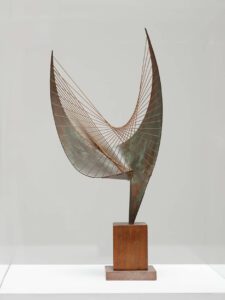Mary Fletcher
This show, curated by Eleanor Clayton, Anne Barlow and Giles Jackson, began in Wakefield at their Hepworth museum and transferred to Tate St Ives, fitting into a smaller space.
Many exhibits are loans from personal collections and unlikely to be assembled again.
Many were new to me, adding to our experience in St Ives where we have the Hepworth studio and garden already as a permanently available experience as well as sculptures in the town out of doors, in the library and the church.
Here we see that Barbara Hepworth used many materials – from glass to string, and participated in different disciplines such as costume design for theatre and her most famous pieces, the monumental symbolic sculpture installed in New York outside the UN building.
Her membership of the local St Ives Labour Party is acknowledged as is her opposition to proliferation of nuclear weapons.
Rachel Cooke wrote in the Guardian of the Wakefield show, ‘it’s sheer tastefulness makes it easy to like but difficult to love.’
This reminded me of Virginia Woolf who s aid of Vanessa Bell and Duncan Grant in 1936, ‘There they sit, looking at pinks and yellows, and when Europe blazes, all they do is screw up their eyes to complain of a temporary glare in the foreground.’
aid of Vanessa Bell and Duncan Grant in 1936, ‘There they sit, looking at pinks and yellows, and when Europe blazes, all they do is screw up their eyes to complain of a temporary glare in the foreground.’
If it wasn’t for Hitler, Hepworth would not have evacuated with her triplets to St Ives from Hampstead.
In St Ives she was influenced by the abstract work of Naum Gabo, also a refugee who went to America. She was also influenced within Cornwall by menhirs and holed ancient Men-an-tol stone on the moors.
The use of abstract forms, of balance, beauty and simplified shapes I see as a balm and relentless enduring hope in the face of world war and threat of nuclear weapons.
The exhibition shows Hepworth’s brave development from her early representational drawing and a cast head to her carved symbolic forms which hark back through the centuries to ancient Celtic and Greek works. She developed the use of pierced holed sculptures and of stringed additions that ask to be played like harps but are, of course, now safely encased.
People who knew her have told me she loved people to touch her sculptures and children to climb on them.
It’s hard to realise now how astonishing it is that Hepworth made her way to international fame at a time when women had far more obstacles to overcome than now even though having a son-in-law who became a director of the Tate (Alan Bowness)may have helped .
In 1967, asked how I would cope with using wood and metal at art school at my interview I replied that Barbara Hepworth had managed it so I was confident that I could. She was a beacon of hope, a trail blazer.
The inclusion of her intimate drawings of surgeons in operating theatres show a remarkable sensitivity – their eyes scrutinising their vital work above their masks seem particularly poignant to me as we so recently wore masks during the Covid pandemic.
I would have liked headphones to hear the Tippett Midsummer Marriage, for which she designed costumes but there is an evocative enlarged photograph of the production.
Barbara Hepworth made work celebrating the Cornish Goonhilly space age communication dishes. She kept up to date.
Sadly she died in a fire at her home in St Ives – which is mentioned in a caption whilst concealing what those who live in St Ives know – that she tragically caused the fire by smoking in bed.
I think telling the audience that would make them see Barbara as more of a real human being rather than an elevated saint of art as if her success was inevitable rather than earned.
It’s a lovely exhibition, one to savour and visit more than once. I feel it succeeds in refreshing our view of Hepworth.
Barbara Hepworth: Art & Life
Tate St Ives, 26 November 2022 to 1st May 2023
